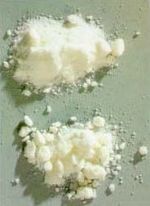可卡因

 Clash Royale CLAN TAG#URR8PPP
Clash Royale CLAN TAG#URR8PPP
body.skin-minerva .mw-parser-output table.infobox captiontext-align:center
 | |
 | |
| 系统(IUPAC)命名名称 | |
|---|---|
methyl (1R,2R,3S,5S)-3- (benzoyloxy)-8-methyl-8-azabicyclo[3.2.1] octane-2-carboxylate | |
| 临床数据 | |
| Drugs.com | Micromedex详细消费者药物信息 |
| 妊娠分级 |
|
| 依赖性 | Physical: Yes[1][2] Psychological: High[2] |
| 成瘾性 | High[3] |
| 给药途径 | 外用、口服、insufflation、靜脈注射 |
| 合法狀態 | |
| 合法状态 |
|
药代动力学数据 | |
| 生物利用度 | 口服:33%[4] Insufflated: 60[5]–80%[6] Nasal spray: 25[7]–43%[4] |
| 代谢 | 肝臟(CYP3A4) |
| 生物半衰期 | 1 小時 |
| 排泄 | 腎臟(苯甲酰芽子堿和芽子鹼甲酯) |
| 识别信息 | |
| CAS注册号 | 50-36-2 |
| ATC代码 | N01BC01 R02, S01, S02 |
| PubChem | CID 5760 |
| IUPHAR/BPS | 2286 |
| DrugBank | DB00907 |
| ChemSpider | 10194104 |
| UNII | I5Y540LHVR |
| KEGG | D00110 |
| ChEBI | CHEBI:27958 |
| ChEMBL | CHEMBL120901 |
| 其他名称 | benzoylmethylecgonine |
PDB配体ID | COC (PDBe, RCSB PDB) |
| 化学信息 | |
| 化学式 | C17H21NO4 |
| 摩尔质量 | 303.353 g/mol |
SMILES
| |
InChI
| |
| 物理性质 | |
| 熔点 | 98 °C(208 °F) |
| 沸点 | 187 °C(369 °F) |
| 水溶液 | HCl: 1800–2500 mg/mL (20 °C) |

從可卡樹葉提煉之純古柯碱
古柯鹼(INN:Cocaine),又譯為古柯碱。為一強烈的興奮劑,是一種毒品[8]。可卡因常以粉末方式由鼻腔吸入或是靜脈注射的方式使用。可能造成的心理影響有思覺失調、欣快感,或者精神激動。生理上的症狀可能包括心跳過速、出汗與瞳孔放大[9]。高劑量的可卡因會造成高血壓或中暑[10]。使用後數秒到分鐘即出現效果,並持續5到90分鐘[9]。可卡因偶爾也會用於醫療用途,例如局部麻醉與減少鼻部手術的出血[11]。
可卡因具有成癮性,原因是由於其作用於腦中的獎賞路徑。短時間使用後,會出現依賴性的高風險[8]。使用可卡因也會增加中風、心肌梗死、肺部問題、敗血症與猝死的風險[8][12]。一般街頭犯罪上販賣的可卡因,常見的會混入局部麻醉藥、玉米澱粉、奎寧或者醣類等會增加額外毒性的物質[13]。持續反覆使用可卡因,會減少感覺快樂的能力與身體疲累[8]。
可卡因是5-羟色胺、去甲基腎上腺素,和多巴胺的再摄取抑制剂,會使腦部這三種神經遞質的濃度上昇[8]。可卡因可以輕易地通過血腦屏障,而且可能會造成血腦屏障的破壞[14][15]。可卡因是由古柯的葉子製成,此一植物的主要產地在南美[9]。2013年合法生產的可卡因數量有419公斤[16]。估計美國每年非法可卡因的市場在一千億到五千億美金之間,可卡因可再經過進一步的加工,製成霹靂可卡因[8]。
每年用藥人數約在1400萬至2100萬人之間,其中北美洲的用量最大,其次為歐洲和南美洲[8]。其中 1-3% 的已開發國家人口在他的一生中至少使用過可卡因一次[17]。2013年,可卡因直接導致約4300人死亡,比起1990年的2400人上升了許多[18]。祕魯人從遠古時代就有嚼食古柯葉的習俗[13]。1860年,可卡因首次由古柯樹的古柯葉內純化出來[8]。1961年起,國際麻醉品單一公約要求各國將所有非醫學用途的可卡因使用列入刑事罪行規範[18]。
歷史
- 最早是亚美利哥·韦斯普奇(Amerigo Vespucci)於西元1499年寫下他對於嚼古柯葉者的印象,這是歐洲人最早的相關記載。在他眼中,這種人兩頰塞滿奇怪的草藥,反芻般地咀嚼不停,實在是他所見過最醜陋最野蠻的人[19]。
- 1855年,德國化學家斐德烈(G.Friedrich)首度從古柯葉中提取出麻藥成份,並命名為「Erythroxylon」。四年後,斐德烈的同事纽曼(A.Newman)又精製出更高純度的物質,替名為「古柯鹼」(Cocaine)。首部以古柯樹為研究的藥用書籍則在1859年出版。
- 1860年,已有醫生由古柯葉中提煉出古柯鹼,並作為醫學用之麻醉藥品。
- 1880年代初期,以6%古柯鹼成分之藥酒問世,稱為馬林安尼。
- 1884年,著名的心理學家佛洛伊德推薦使用古柯鹼來作為酒精與嗎啡上癮之替代藥品。
- 1886年問世之可口可樂,尚含有微量古柯鹼,不過可口可樂后於1906年排除此配方。
- 2009年時,紅牛能量飲料(Red Bull Energy Drink)曾被台灣及香港驗出有微量古柯鹼成份,但不會影響人體。
參考文獻
^ Freye, Enno. Pharmacology and abuse of cocaine, amphetamines, ecstasy and related designer drugs a comprehensive review on their mode of action, treatment of abuse and intoxication Online-Ausg. Dordrecht: Springer. 2009: 63. ISBN 9789048124480.
^ 2.02.1 Hamid Ghodse. Ghodse's Drugs and Addictive Behaviour: A Guide to Treatment 4. Cambridge University Press. 2010: 91. ISBN 9781139485678.
^ Introduction to Pharmacology Third Edition. Abingdon: CRC Press. 2007: 222–223. ISBN 9781420047424.
^ 4.04.1 Fattinger K, Benowitz NL, Jones RT, Verotta D. Nasal mucosal versus gastrointestinal absorption of nasally administered cocaine. Eur. J. Clin. Pharmacol. 2000, 56 (4): 305–10. PMID 10954344. doi:10.1007/s002280000147.
^ Barnett G, Hawks R, Resnick R. Cocaine pharmacokinetics in humans. J Ethnopharmacol. 1981, 3 (2–3): 353–66. PMID 7242115. doi:10.1016/0378-8741(81)90063-5.
^ Jeffcoat AR, Perez-Reyes M, Hill JM, Sadler BM, Cook CE. Cocaine disposition in humans after intravenous injection, nasal insufflation (snorting), or smoking. Drug Metab. Dispos. 1989, 17 (2): 153–9. PMID 2565204.
^ Wilkinson P, Van Dyke C, Jatlow P, Barash P, Byck R. Intranasal and oral cocaine kinetics. Clin. Pharmacol. Ther. 1980, 27 (3): 386–94. PMID 7357795. doi:10.1038/clpt.1980.52.
^ 8.08.18.28.38.48.58.68.7 Pomara, C; Cassano, T; D'Errico, S; Bello, S; Romano, AD; Riezzo, I; Serviddio, G. Data available on the extent of cocaine use and dependence: biochemistry, pharmacologic effects and global burden of disease of cocaine abusers.. Current medicinal chemistry. 2012, 19 (33): 5647–57. PMID 22856655.
^ 9.09.19.2 Zimmerman, JL. Cocaine intoxication.. Critical care clinics. October 2012, 28 (4): 517–26. PMID 22998988.
^ Connors, NJ; Hoffman, RS. Experimental treatments for cocaine toxicity: a difficult transition to the bedside.. The Journal of pharmacology and experimental therapeutics. November 2013, 347 (2): 251–7. PMID 23978563.
^ Harper, SJ; Jones, NS. Cocaine: what role does it have in current ENT practice? A review of the current literature.. The Journal of laryngology and otology. October 2006, 120 (10): 808–11. PMID 16848922.
^ Sordo, L; Indave, BI; Barrio, G; Degenhardt, L; de la Fuente, L; Bravo, MJ. Cocaine use and risk of stroke: a systematic review.. Drug and alcohol dependence. 1 September 2014, 142: 1–13. PMID 25066468.
^ 13.013.1 Goldstein, RA; DesLauriers, C; Burda, AM. Cocaine: history, social implications, and toxicity--a review.. Disease-a-month : DM. January 2009, 55 (1): 6–38. PMID 19081448.
^ Sharma, HS; Muresanu, D; Sharma, A; Patnaik, R. Cocaine-induced breakdown of the blood–brain barrier and neurotoxicity. International Review of Neurobiology. International Review of Neurobiology. 2009, 88: 297–334. ISBN 978-0-12-374504-0. PMID 19897082. doi:10.1016/S0074-7742(09)88011-2.
^ Karch, Steven B. Karch's pathology of drug abuse 4. Boca Raton: CRC Press. 2009: 70. ISBN 9780849378812.
^ Narcotic Drugs 2014 (pdf). INTERNATIONAL NARCOTICS CONTROL BOARD. 2015: 21. ISBN 9789210481571.
^ GBD 2013 Mortality and Causes of Death, Collaborators. Global, regional, and national age-sex specific all-cause and cause-specific mortality for 240 causes of death, 1990-2013: a systematic analysis for the Global Burden of Disease Study 2013.. Lancet. 17 December 2014. PMID 25530442. doi:10.1016/S0140-6736(14)61682-2.
^ Room, R; Reuter, P. How well do international drug conventions protect public health?. Lancet. 7 January 2012, 379 (9810): 84–91. PMID 22225673.
^ 書名:上癮五百年,David T. Courtwright著,薛絢譯,立緒出版
| ||||||||||||||||||||||||||||||||||||||||||||||||||||||||||||||||||||
| ||||||||||||||||||
| ||||||||||||||
| ||||||||||||||||||||||||||
| ||||||||||||||||||||||
| ||||||||||||||||||
| ||||||||||||||
|